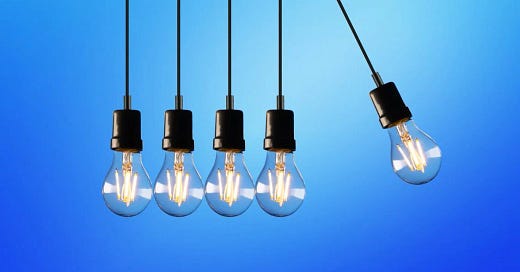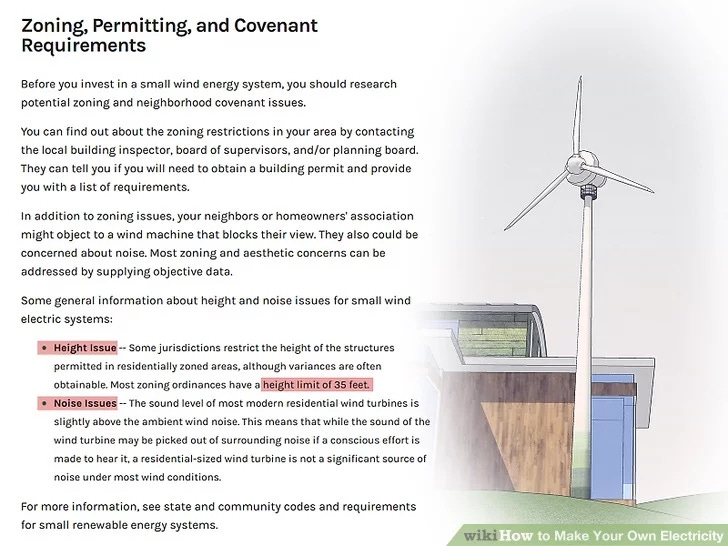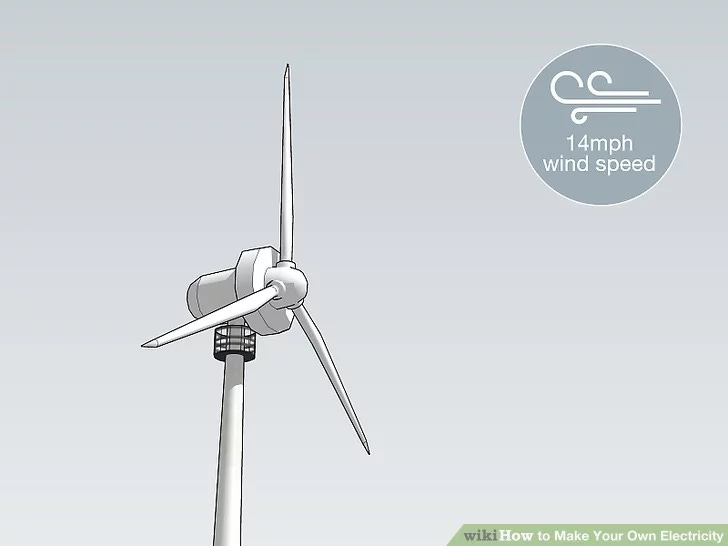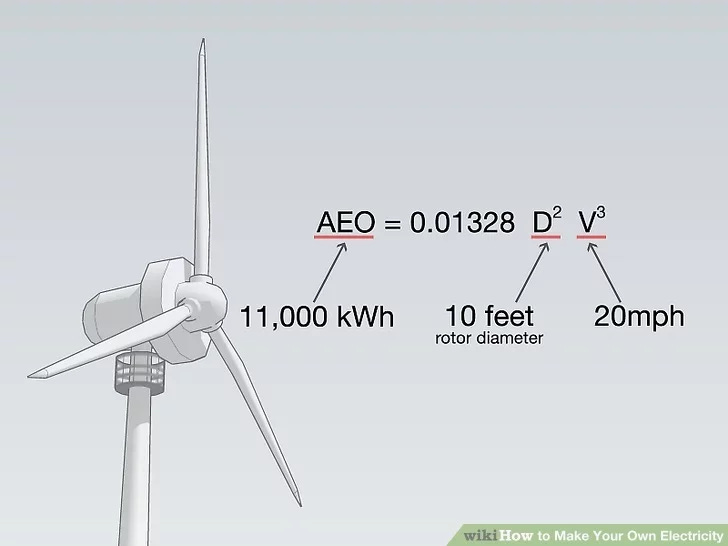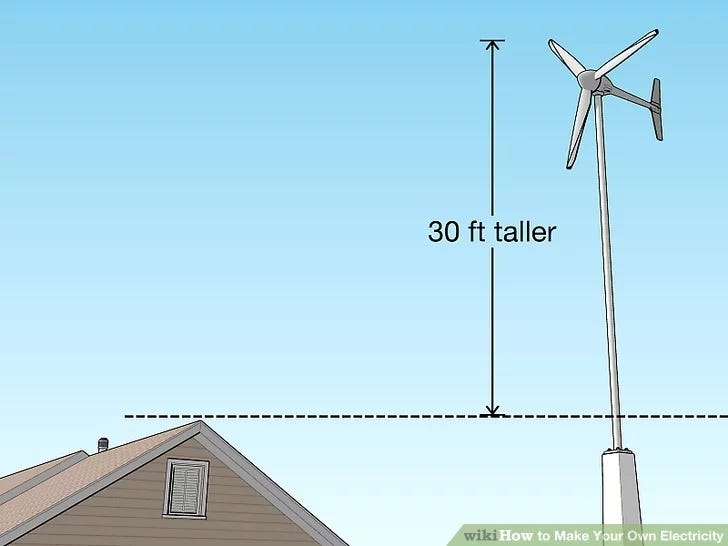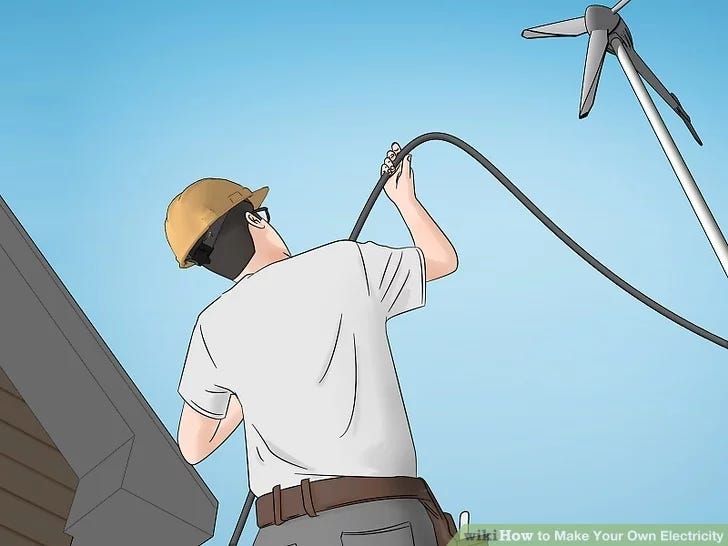How Can I Produce My Own Energy?_Electricity
If you want to lower your cost, generating your own electricity through renewable sources can have a huge impact. If you live in an area that’s pretty windy, a small-scale wind turbine can work well too. Just be sure to check with local regulations to make sure you’re allowed to install either system!
Installing a Small Wind System
1. Check the zoning restrictions in your area for the maximum structure height. Since wind systems are tall, you may not be able to install the system in a residential area depending on your zoning requirements. Check with local building inspectors or your city’s homeowner’s association to see if you’re eligible for building a turbine. If zoning isn’t an issue, then you can build a turbine on your property.
Many zoning ordinances have a height limit of about 35 feet (11 m), and many wind systems need to be 30 feet (9.1 m) higher than the tallest structure within 500 feet (150 m).
2. Opt for a turbine if the average wind speed is 14 mph (23 km/h) or more. Look online for wind speed maps or airport wind speed data to see what the average wind speed is in your area. If the average wind speeds are around 14 miles per hour (23 km/h), then a turbine might be an efficient way to generate electricity to power your home. If the wind speed is slower, then you may not get the turbine’s full effectiveness.
Wind speeds increase the higher above ground you are. Many airports measure their wind speed from about 30 feet (9.1 m) above ground, which is similar to the height of a residential turbine.
Hire a professional who installs wind turbines to check the efficiency and wind speed of your property for you if you have trouble determining it yourself.
3. Calculate the minimum diameter for the turbine blades to power your home. Check with your electric company to find out how many kilowatt-hours your home used in the past year. Use the formula AEO = (0.01328)D2V3, where AEO is your annual energy output in kilowatt-hours per year, D is the diameter of the rotor in feet, and V is the annual average wind speed in miles per hour. Solve the formula for D and buy a turbine system with the correct size rotors.
For example, if you use 11,000 kilowatt-hours of electricity per year and the average annual wind speed is 20 miles per hour, your formula would be 11,000 = (0.01328)D2(15)3. If you solve for D, the diameter you need for your system is about 10 feet (3.0 m).
Once you know what size turbine you need, purchase one from a reputable supplier. This company may also be able to supply you with other crucial parts (like the tower) and/or complete the installation.
4. Place the turbine on a tower that’s 30 feet (9.1 m) taller than other structures. Wind systems work the most efficiently when they’re at least 30 feet (9.1 m) higher than any structure within 500 feet (150 m). Purchase a tower that’s the height you need from the same supplier that as your turbine. Secure the bottom of the tower in a concrete foundation so it’s sturdy. Assemble the pieces of the tower and connect the turbine on top.
Ask the company you bought the turbine from to see if they offer building and installation. Otherwise, if you don’t feel comfortable building your turbine, hire a professional service to do it for you.
Warning: Avoid mounting wind turbines on a roof since they can be noisy and they aren’t as efficient due to wind turbulence.
5. Hire an electrician to connect the turbine to your home’s power system. Run the wires attached to the motor of the turbine through the tower toward your home’s power supply. Hire a professional electrician to bury the wires in your yard and then connect them to your switchboard. Once it’s connected, the wind will spin the rotors and provide you with electricity.
Your electric company may also install another power meter to see how much electricity your turbine is generating. If you generate more than you use, you may also get reimbursement for it.
Thanks for reading__
I will write more about ‘How To Produce Your Own Energy and Save It For Future’. If you want to learn more about this, consider signing up for my newsletter.
Read more:


